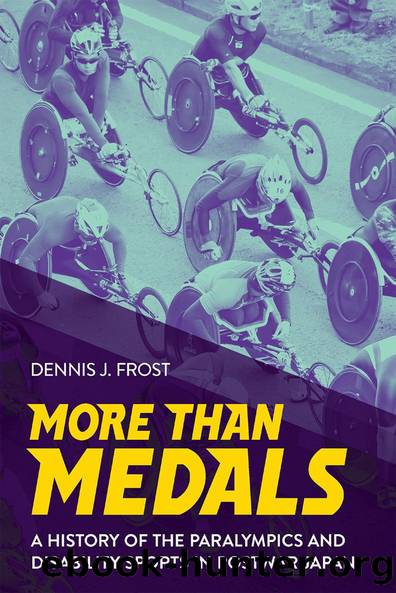More Than Medals by Dennis J. Frost

Author:Dennis J. Frost [Frost, Dennis J.]
Language: eng
Format: epub
Tags: History, Asia, Japan, Sports & Recreation, Olympics & Paralympics, Disability Sports
ISBN: 9781501753091
Google: PzXUDwAAQBAJ
Publisher: Cornell University Press
Published: 2021-01-15T01:44:03+00:00
A World beyond the 1998 Games
Given these sorts of policy changes, the financial outlays that they entailed, and the various human-friendly campaigns just described, it is understandable that many people at the time and since have credited Naganoâs Paralympics with advancing barrier-free principles in the region and in Japan more broadly.33 At the very least, it would seem that these Gamesâmuch like the FESPIC Games in Kobeâserved as a fresh and pressing incentive for enacting preexisting plans and measures designed to support those with disabilities. Yet therein lies a key point, one that can be easily overlooked when focusing on the legacies of these sorts of events: neither Nagano nor Japan was a blank slate, waiting for the Paralympics to leave their marks. To understand why and how the 1998 Paralympics had the impact that they did, it is also necessary to take into account a number of factors beyond the Games themselves.
For one, the response to the Paralympics in Nagano was grounded in the regionâs significantly longer history of engagement with progressive disability-related approaches. As early as 1975 (predating the first Winter Paralympic Games), the Ministry of Health and Welfare designated Nagano City as one of its Social Welfare Model Cities. The cityâs initial long-term plan for promoting accessibility dated from the early 1980s and was explicitly linked with, if not directly inspired by, the UN International Year of Disabled Persons. The guidelines that the city later revised in the lead-up to the Games had already been on the books for more than a decade. The initial tagline for these older guidelines, âDeveloping a community where everyone can live well,â reflected a clear commitment to fostering greater accessibility, even if the guidelines themselves lacked the legal heft that the later prefectural ordinance provided.34
These earlier policies serve as reminders that many people in the region had been working to improve accessibility well before the Paralympics. Miura JirÅ, the Paralympic torch runner from Miyata Village who had been active locally for some fifteen years, was a case in point. In addition, support for hosting the Games in Nagano emerged early on at both the governmental and volunteer levels in no small part because organizers were not starting from scratch. A volunteer group like NPBK might have been formed specifically in response to the Paralympics, but many of its members were already engaged in various forms of disability-related advocacy. As just one example, Ikeda Jun, a vice chair of NPBK, had been a long-time prefectural case worker who had become involved with the Independent Living Movement as it was beginning to gain support in Japan during the late 1980s and early 1990s. A key participant in NPBKâs school outreach programs, Ikeda was instrumental in launching the groupâs study tour to the United States. In the months immediately following the Paralympics, he helped establish Human Net Nagano, an NGO dedicated to promoting and supporting opportunities for people with disabilities to live independently in their home communities. Although Human Net Nagano might be considered
Download
This site does not store any files on its server. We only index and link to content provided by other sites. Please contact the content providers to delete copyright contents if any and email us, we'll remove relevant links or contents immediately.
| Africa | Americas |
| Arctic & Antarctica | Asia |
| Australia & Oceania | Europe |
| Middle East | Russia |
| United States | World |
| Ancient Civilizations | Military |
| Historical Study & Educational Resources |
Machine Learning at Scale with H2O by Gregory Keys | David Whiting(4200)
Never by Ken Follett(3801)
Fairy Tale by Stephen King(3231)
The Man Who Died Twice by Richard Osman(2998)
Oathbringer (The Stormlight Archive, Book 3) by Brandon Sanderson(2907)
Will by Will Smith(2797)
Rationality by Steven Pinker(2295)
The Dark Hours by Michael Connelly(2246)
Can't Hurt Me: Master Your Mind and Defy the Odds - Clean Edition by David Goggins(2230)
Friends, Lovers, and the Big Terrible Thing by Matthew Perry(2127)
The Dawn of Everything: A New History of Humanity by David Graeber & David Wengrow(2124)
Principles for Dealing With the Changing World Order: Why Nations Succeed and Fail by Ray Dalio(1975)
HBR's 10 Must Reads 2022 by Harvard Business Review(1782)
A Short History of War by Jeremy Black(1764)
Go Tell the Bees That I Am Gone by Diana Gabaldon(1691)
515945210 by Unknown(1603)
A Game of Thrones (The Illustrated Edition) by George R. R. Martin(1597)
Kingdom of Ash by Maas Sarah J(1538)
443319537 by Unknown(1473)
